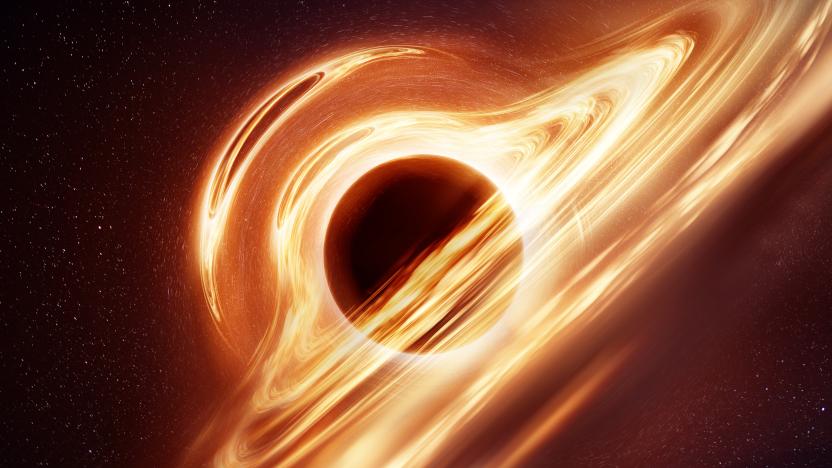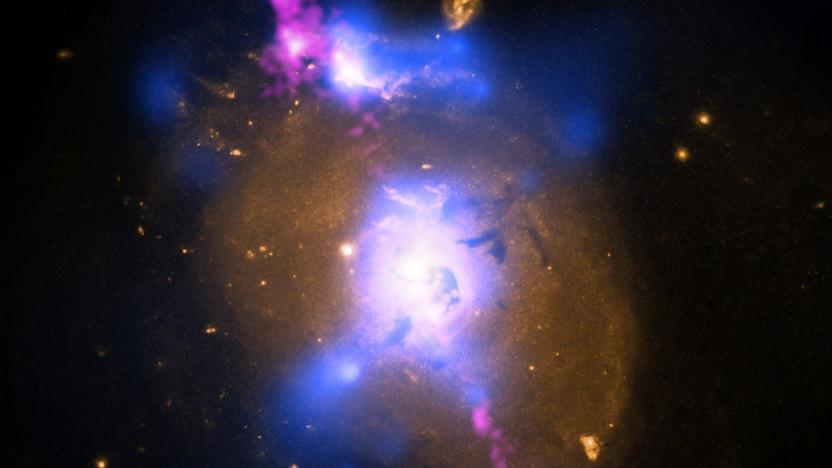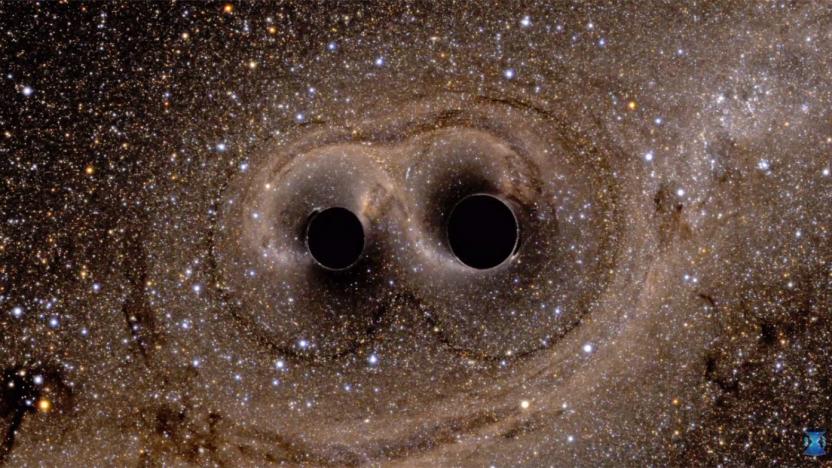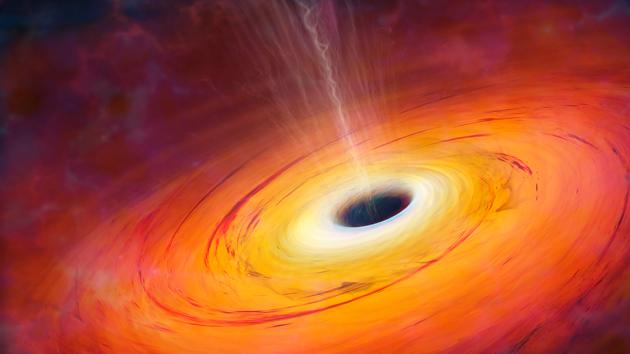relativity
Latest

Black hole 'quantum hair' might solve a decades-old scientific paradox
Scientists claim to have solved a scientific paradox by determining that black holes have 'quantum hair.'

Test can show if the speed of light has changed
Modern science assumes that the speed of light has always been the same. Researchers have suggested that this seeming constant might have changed over time, however, and they now have a way to find out whether or not that's true. Professors João Magueijo and Niayesh Afshordi have developed a prediction that should test for changes in light speed. They've given the fluctuations in density the early universe, detectable through cosmic background radiation, an exact spectral index number based on the theory that light was much faster in the first seconds following the Big Bang (0.96478, if you're curious). If future measurements of the index line up with this number, they'll support the notion that light speed has shifted.

Science confirms that gravitational waves exist
At last, scientists have validated a key part of Einstein's general theory of relativity. The National Science Foundation, Caltech and MIT have confirmed the existence of gravitational waves, or ripples in spacetime. Their two LIGO (Laser Interferometer Gravitational-wave Observatory) detectors measured atomic-scale differences on September 14th, 2015 that point to the collision of black holes (also a new discovery) 1.3 billion years ago, triggering gravity ripples that only just reached Earth. There have long been hints of these waves, but hard evidence has proven elusive until now.

Researcher finds a way to mimic curves in space-time
Here on Earth, it's rather difficult to replicate curved space-time -- to get that kind of effect in nature, you'd have to get uncomfortably close to black holes and other distant space objects. However, researcher Nikodem Szpak may have found a way to simulate that bend without facing oblivion. His proposed technique puts supercooled atoms in an optical lattice created by a laser field; so long as the laws of quantum mechanics and thermodynamics hold true, the atoms should behave like they're experiencing curved space-time. You can even change the lattice's pattern to mimic different circumstances, whether it's a moment right after the Big Bang or the surface of a star.

Quantum data lock promises leak-proof security
Quantum cryptography is secure against intruders, since you can't intercept data in mid-flight without ruining it. The technology won't always stop leaks, however, which is why the University of Cambridge has developed a new protocol that keeps participants honest. The method combines the theories of both quantum physics and special relativity to preserve data in a locked state that isn't readable unless the sender provides a key; the laws of physics prevent anyone from decrypting the info beforehand. While we won't see any practical application of this quantum lock for a while, it could prove vital to financial traders and others who can't always trust their contacts.

MIT's relativistic OpenRelativity toolkit now freely available
MIT Game Lab's OpenRelativity toolset, which powered its psychedelic first-person collection game/physics demonstration A Slower Speed of Light, is now available for free through Github. The toolkit works in both free and paid versions of Unity. OpenRelativity allows for the real-time simulation of principles such as time dilation, Lorentz transformation and relativistic Doppler shift by allowing the designer to augment the ways in which light behaves. As it turns out, light moving at the speed it normally does is pretty dang essential to our world not transforming into a disorienting funhouse where cause and effect are meaningless. Who could have guessed?

'A Slower Speed of Light' is an open-source game on special relativity from MIT Game Lab
The behavior of light may seem static and uninteresting (it's bright and fast, we get it), but there's actually an incredible amount of science going on that we generally don't experience during our normal lives.A Slower Speed of Light, a new open-source game for PC and OSX from MIT Game Lab, explores the more intricate and interesting behaviors of light in a "relativistic game engine." As players collect objects, the speed of light is slowed and players are able to experience phenomena such as the Doppler effect, time dilation and the Lorentz transformation, among others.While the open-source aspects of this project are not yet available, the plan is to release the game's Unity3D-based engine as OpenRelativity sometime in 2013. For now, the game itself can be downloaded here. %Gallery-170585%

Faster-than-light neutrinos are back in the game
Back in September, CERN dropped the improbable news about its faster-than-light neutrinos, causing eggheads worldwide to cry foul. Understandable really, as if true, a lot of what we think we know about the universe essentially falls apart. So, expect severe bouts of head-scratching once more, as a second round of experiments from the same OPERA collaborative has reported similar results. The initial experiments used a long chain of neutrinos, fired from point A to B. Skeptics claimed that this might have introduced an element of uncertainty to the results -- the new tests used much shorter blasts, meaning that if they arrived just as quickly, then this potential cause for error is scratched out. The new data still needs to undergo the usual peer review, and other possible causes for error remain. For now though, it looks like one of the main arguments against has been addressed, making the Einstein-challenging neutrinos one step closer (or is that ahead?) to re-writing the rule book.

Remember those faster-than-light neutrinos? Great, now forget 'em
A week ago the world went wild over CERN's tentative claim that it could make neutrinos travel faster than light. Suddenly, intergalactic tourism and day trips to the real Jurassic Park were back on the menu, despite everything Einstein said. Now, however, a team of scientists at the University of Groningen in the Netherlands reckons it's come up with a more plausible (and disappointing) explanation of what happened: the GPS satellites used to measure the departure and arrival times of the racing neutrinos were themselves subject to Einsteinian effects, because they were in motion relative to the experiment. This relative motion wasn't properly taken into account, but it would have decreased the neutrinos' apparent journey time. The Dutch scientists calculated the error and came up with the 64 nanoseconds. Sound familiar? That's because it's almost exactly the margin by which CERN's neutrinos were supposed to have beaten light. So, it's Monday morning, Alpha Centauri and medieval jousting tournaments remain as out of reach as ever, and we just thought we'd let you know.

Universe expansion: dark energy's out, anti-gravity's in, matter and antimatter still can't get along
Dark energy, we barely knew you, but before we ever found out if you were, in fact, the invisible hand pushing the cosmos apart, an Italian scientist ginned up a new theory that has anti-gravity doing the Yoko Ono to the universe's merry band of galaxies. Massimo Villata's theory assumes that both matter and antimatter have positive mass and energy density, which gets particles attracting particles and antiparticles attracting antiparticles through the force of gravity. To give dark matter the heave-ho from the galactic expansion equation, Villata supposes that the theory of general relativity applies in reverse to antimatter particles to create anti-gravity. And just as gravity pulls particles together, anti-gravity shoves them apart -- giving the universe its burgeoning waistline, no clown, king, or colonel required.

String theory finds an elegant use for itself with qubit entanglement and black holes
Sure, trying to wrap your head around string theory -- a study in particle physics that's trying to rectify the perceived contradictions between general relativity and quantum mechanics -- can cause more cognitive pain than a colliding god particle. That hasn't stopped anyone from trying to validate its corollaries, and in the interim, researchers like Michael Duff of the Imperial College London. Mr. Duff realized a few years ago there existed some strong relations between formulas pertaining to both black holes (relativity) and four entagled qubits (quantum mechanics). So, in his words, "In a way, there's bad news and good news in our paper. The bad news is, we're not describing the theory of everything. The good news is, we're making a very exact statement which is either right or wrong. There's no in between." We're sure some science cliques are already gearing up to get their troll on. Hit up the PDF below if you want to read it yourself.




